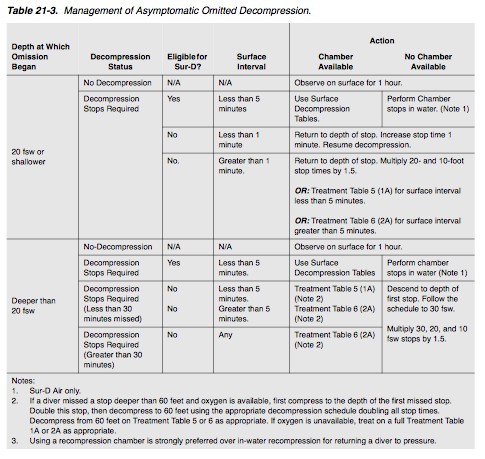Bubbletrubble
Contributor
If you did not have a deco obligation and you did not exceed the recommended ascent rate on your computer (33 ft/min), then missing the optional safety stop is not a big deal. It means that you still had a very low risk of DCS. In your case, the risk of bubble-pumping (caused by re-descending to make up the missed safety stop) probably outweighs the risk of DCS.
For the two divers on air who may have blown a minor deco obligation (let's say 5 min at 10 ffw) and were asymptomatic for DCS, it would probably be best for them to stay on the surface and take it easy. With medical facilities and a hyperbaric chamber nearby, that's what I'd be inclined to do. Some divers might recommend going back down to make up the deco stop. That would probably be OK so long as the shallow deco stop is extended (10-15 minutes) and gas supplies allow for that.
If either of them began to show signs of DCS, then they should get on oxygen ASAP and head straight to the nearest hyperbaric chamber.
In case you're interested, here's a chart illustrating U.S. Navy management for Asymptomatic Omitted Decompression (taken from the U.S. Navy Diving Manual):

On a side note, it sounds to me like the divers on air never had their computers trip over into deco mode. The last thing you want to do in that situation is lose buoyancy control. It's very strange that experienced divers would ever have a problem like that. That's two glaring errors on one dive.
For the two divers on air who may have blown a minor deco obligation (let's say 5 min at 10 ffw) and were asymptomatic for DCS, it would probably be best for them to stay on the surface and take it easy. With medical facilities and a hyperbaric chamber nearby, that's what I'd be inclined to do. Some divers might recommend going back down to make up the deco stop. That would probably be OK so long as the shallow deco stop is extended (10-15 minutes) and gas supplies allow for that.
If either of them began to show signs of DCS, then they should get on oxygen ASAP and head straight to the nearest hyperbaric chamber.
In case you're interested, here's a chart illustrating U.S. Navy management for Asymptomatic Omitted Decompression (taken from the U.S. Navy Diving Manual):

On a side note, it sounds to me like the divers on air never had their computers trip over into deco mode. The last thing you want to do in that situation is lose buoyancy control. It's very strange that experienced divers would ever have a problem like that. That's two glaring errors on one dive.





